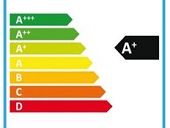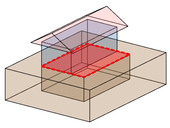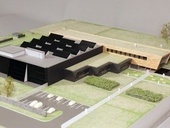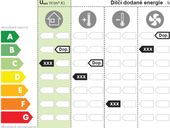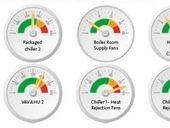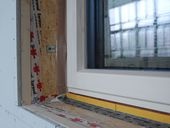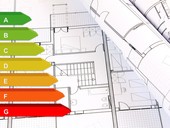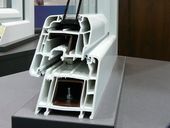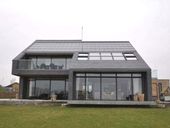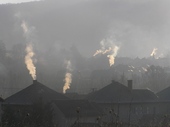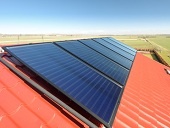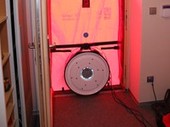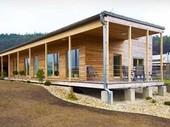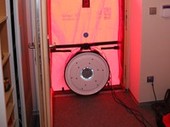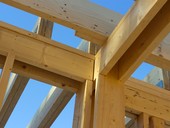Turbulent but often incompetent discussions about more stringent building-energy requirements are accompanied by calculations proving - often biased - what is needed. The article deals with the problem of reliability of building-energy calculations, especially when combined with financial evaluation. The stochastic calculation of energy performance of a large sample of buildings is used. Costs increase of low-energy solutions is discussed.
Archiv článků od 15.10.2012 do 10.6.2013
Of course, the social order is low-energy buildings to be also effective. However, this objective cannot be only declarative nature, but must be supported by correct results showing that the investment plan will generate real economic effect in the form of profit or positive cash flow for an investor or user for the period considered.
Building Act (Act. No. 183/2006 Coll.) in its regulations frequently uses the term of built up area, particularly in the context of built up area of building (hereinafter referred to as “built up area”). Correct determination of built up area is highly significant. Unfortunately, the Building Act did not contain a definition and a method of determining the built up area.
On January 1, 2013 came into effect an extensive amendment of the Building Act (Act No. 350/2012 Coll.). The aim of a legislature was to bring clarity and to provide clear way to determine the built up area. This is defined in § 2 clause (7) of this Act. This definition is not considered unambiguous, though.
The aim of this paper is to analyze the regulations of the Building Act in detail and to find a probable way of correct determination of the built up area. All facts presented in this paper should be taken as the opinions of the authors and should not be considered as a binding interpretation of the law, which is due only to the independent court.
The University Centre of Energy Efficient Buildings is a newly established interdisciplinary research institute of Czech Technical University focused to energy efficient buildings having the healthy indoor environment that, at the same time, are environmentally friendly. The main objective for the Centre establishment is the development of technologies for the energy demand reduction and the efficient improvement of natural sources concerning new constructions and reconstructions of existing buildings. The objective is to be achieved by the holistic approach, the expert knowledge concentration from the field of architecture, construction, mechanical engineering, information technologies, and hygiene of indoor environment and the top instrument equipment of the Centre.
In relation with the implementation of the revised EU Directive 2010/31/EU on the energy performance of buildings are currently changing some of Czech legal regulations and new methodology for energy performance assessment is introduced . This article focuses on an example rating the standard family house with conventional solution of building envelope and technical systems, using the new evaluation method. For this object will be also an obligation to issue an energy performance certificate as required by the Consolidated Act No. 406/2000 Coll., as amended.
One of the reasons why building with almost zero energy consumption does not meet the expectation is that it may be too complicated. Another factor is that the project may be too optimistic, and other unforeseen factors, such as office equipment, which actually dominates the energy balance of the building.
The European Union is committed to reducing energy consumption in the built environment. Since the heating, ventilation and air conditioning (HVAC) represents approximately 11% of the total electricity consumption in Europe, these systems are an important part of the commitment of the EU. In this article, we discuss two specific aspects of HVAC energy efficiency, both are based on that understanding how the commercial buildings work in real life is the first step towards reducing energy consumption.
It has been one year and a half since Technical Standards Information TNI 74 6077 – The windows and external doors – Requirements for incorporation has been published. What is the consistency or inconsistency between the demands on windows and doors manufacturing, their installation and actually reached geometrical tolerances of building construction? What this state brings to manufacturers of windows and doors, what to building contractor and what to customers? The view through the eyes of quality control.
In connection with the implementation of the revised European Directive 2010/31/EU on the energy performance of buildings, certain legislative provisions such as Decree No. 148/2007, Coll. Replaced by Decree No. 78/2013, Coll. are currently amending. This article is focused on the changes associated with the energy certification of buildings, the "ENB", from the perspective of changes in the evaluation ENB.
Information and access to technical standards plays very important role, when construction products are placed on the EU market. For the purpose of it can be very effective to use web of Czech office for standards, metrology and testing. Basic data for web are prepared by Institute for testing and certification. ČSN standard references placed in this web are connected with ÚNMZ web service „CSN on-line” and makes possible users of this service directly access to full texts.
This paper deals with the classification of test properties of windows and entrance doors in terms of usability for practical use. Those classification classes are very important for the use of acquired functional properties of hole filling for use of the products in the country. Based on the above, it is then possible to determine the specific levels of performance that should be achieved by a product to demonstrate suitability. In summary, attention is also focused on technical thermal and acoustic properties of hole filling in terms of usability for additional practice.
Achieving quality and healthy indoor environment in buildings with very low energy consumption means a holistic attitude from the initial design of the building to its operation. This attitude to design also raises the need for a holistic attitude to the measurement / evaluation of the structures, both in terms of quantitative indicators and qualitative.
Since the combustion of solid fuels in heating boilers is attended by emissions of pollutants, in individual EU countries are gradually adopted different tightening requirements (emission and efficiency), which the appliance must meet. Requirements are targeted both the producers or importers of the combustion devices and theirs' operators. The aim of this article is to provide an overview of current and oncoming requirements and also show their comparison.
The aim of this article is to highlight the ever increasing importance of a comprehensive evaluation of the energy balance of buildings and present a set of results of student work in this field which can be used for explanation the basic relations and ideas about the current impact of the Czech residential buildings on the environment.
Series of articles discusses the way of determination of setting the limits of the building envelope air-tightness and its influence on the total value of air permeability, and analyzes the influence of including the elements inside the building to the total value of air permeability. Analysis included 6 experimental houses and proofed the influence of calculated border of building envelope and above all the influence of inside elements like furniture or inside structures.
Series of articles discusses the way of determination of setting the limits of the building envelope air-tightness and its influence on the total value of air permeability, and analyzes the influence of including the elements inside the building to the total value of air permeability. Analysis included 6 experimental houses and proofed the influence of calculated border of building envelope and above all the influence of inside elements like furniture or inside structures.
Series of articles discusses the calculation way of setting limits the building envelope air-tightness and its influence on the total value of air permeability, and analyzes the influence of counting the elements the internal volume of building inside to the total value of air permeability. The analysis was carried out under a university qualification work on a set of six experimental houses and in some cases demonstrated to influence the total value of air permeability as calculated boundary envelope air-tightness and especially elements within measured volume of space such as furniture, interior design or lining holes.
Development of wooden buildings in the Czech Republic is based on the requirement to implement the most low-energy buildings. Still there are many people who are afraid of wooden buildings mainly because of their misconceptions about their behaviour under fire. But the truth is that in a fire wood doesn’t lose its rigidity and strength, and the remaining sections of wood elements are also able to carry the load.
zpět na aktuální články

